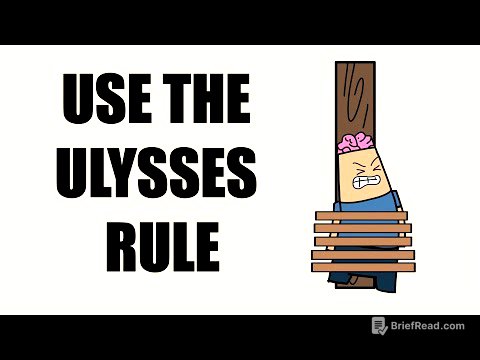TLDR;
This video provides an overview of medicine in medieval England, emphasizing the continuity of medical ideas and practices due to the influence of the Church. It covers prevailing beliefs about disease, including divine punishment, astrology, the four humors theory, and miasma. The video also discusses available treatments, healers, and the impact of the Black Death on medical thought and practices.
- The Church's control over education, communication, and attitudes reinforced traditional medical ideas from Hippocrates and Galen.
- Common beliefs about the causes of disease included God's punishment, astrological influences, imbalances in the four humors, and miasma.
- Treatments varied from religious practices to balancing the humors through bloodletting, purging, and herbal remedies.
- The Black Death led to some new ideas, such as the recognition of contagion, but also reinforced existing beliefs and practices.
Introduction: Medicine in Medieval England [0:00]
The video introduces the topic of medicine in medieval England, highlighting that this period was characterized by continuity rather than significant change. The primary reason for this lack of change was the pervasive influence of the Church, which controlled various aspects of life, including attitudes, communication, and education. The Church promoted conservative views, respect for tradition, and adherence to ancient medical authorities like Hippocrates and Galen, which stifled the development and acceptance of new medical ideas.
The Church's Influence on Medicine [0:21]
The Church exerted considerable control over medical knowledge and practices in medieval England. It fostered a conservative mindset, discouraging the questioning of traditional beliefs and ancient ideas. The absence of a printing press until 1440 meant the Church controlled the production and dissemination of books, suppressing any ideas that contradicted its teachings. The Church also funded universities, influencing the training of doctors to rely on book learning rather than practical experiments, limiting opportunities for new discoveries and challenges to established theories.
Prevailing Ideas: God and Sin [2:00]
One dominant belief was that disease was a punishment from God or a test of faith, an idea propagated by the Church and reinforced by biblical stories. This belief led to religious approaches to treatment, such as prayers, Catholic Mass, and pilgrimages to holy sites. People also believed in the King's touch as a cure, as the King was considered divinely chosen. Prevention methods included prayer and avoiding sin to remain in God's favor, as well as maintaining personal hygiene, which was linked to godliness.
Astrology and Medicine [3:31]
Astrology was another influential idea, suggesting that the position of planets and stars, especially at the time of birth, could affect health. Initially resisted by the Church, astrology gained acceptance, particularly after the Black Death, aligning with Hippocrates' writings on the influence of celestial bodies on the body's humors. Physicians used star charts to diagnose patients and determine appropriate treatments based on planetary positions at the patient's birth.
The Four Humors Theory [4:30]
The four humors theory posited that the body contained four liquids—blood, phlegm, black bile, and yellow bile—and that an imbalance among these could cause illness. This rational theory, based on observable evidence, originated from the writings of Hippocrates and Galen, supported by the Church. Treatments aimed to restore balance through methods like purging, bloodletting, and inducing vomiting. The "treatment of opposites," derived from Galen, involved using remedies with opposite characteristics to the imbalanced humor.
Miasma Theory [7:14]
The miasma theory attributed disease to bad air and smells from rotting matter. This rational idea, rooted in the works of Hippocrates and Galen, was also supported by the Church, which linked bad smells to sin. Prevention methods included maintaining personal cleanliness, using sweet herbs and perfumes to combat bad odors, and some disorganized attempts to improve public health by cleaning away filth.
Healers and Healthcare [8:41]
Access to healthcare depended on affordability and the nature of the disease. Physicians, university-educated and trained by the Church, were the most expensive and primarily diagnosed diseases for wealthy patients from a distance, using star charts and urine analysis. Apothecaries offered more affordable herbal remedies, while barber surgeons provided basic surgical procedures at the lowest cost. Hospitals, run by the Church, focused on providing hospitality and basic care rather than medical treatment, often excluding infectious patients and pregnant women. Most ordinary people received treatment at home, mainly from women in the family who used herbal remedies.
Case Study: The Black Death [11:24]
The Black Death of 1348 led to some new ideas and prevention methods. The disease, with its bubonic and pneumonic forms, was blamed on miasma, unbalanced humors, divine punishment, and planetary positions. New ideas included linking the disease to volcanic eruptions and recognizing its spread through contact. Treatments included prayer, rebalancing humors, and attempting to burst buboes. New prevention methods involved flagellation, carrying posies, avoiding bathing, and implementing quarantines, though the latter were not very effective due to weak local government enforcement.
Knowledge Check and Exam Technique [13:51]
The video includes a multiple-choice knowledge check to test comprehension of the material. It also provides an example of an exam question and guidance on how to structure an effective response, emphasizing the importance of sustained explanations and using explanatory phrases.









